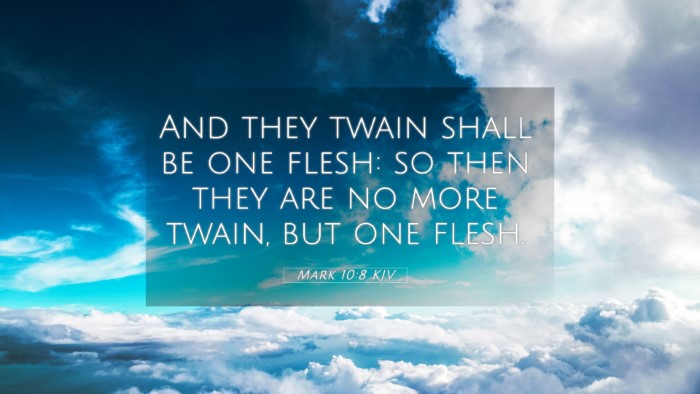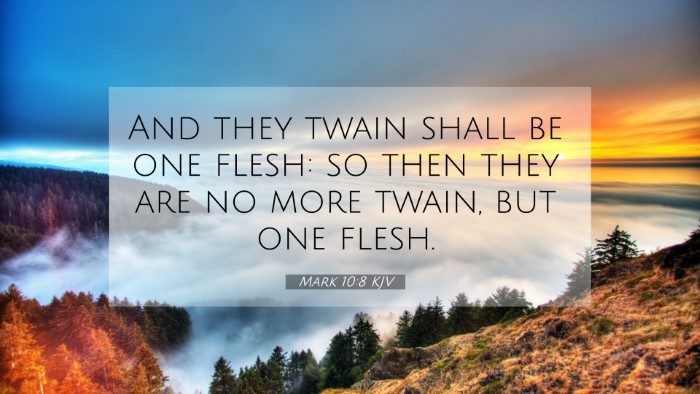Understanding Mark 10:8
Mark 10:8 states: "And the two shall become one flesh; so they are no longer two but one flesh." This verse highlights the divine intention behind marriage, emphasizing the unity of two individuals into one entity. It draws from the foundational concept of marriage established in Genesis and reiterated by Jesus to affirm its sacredness and permanence.
Verse Meaning Summary
This verse encapsulates profound theological truths about the nature of marriage. In this passage, Jesus references God's original design for human relationships, showcasing the bond between husband and wife as both spiritual and physical. The merging into one flesh signifies a deep, complete union that transcends mere coexistence.
Insights from Public Domain Commentaries
- Matthew Henry: Henry emphasizes that this union is not merely about companionship but reflects a divinely instituted relationship intended for mutual support and obligation. He notes that the reference to "one flesh" implies a mix of physical and spiritual dimensions.
- Albert Barnes: Barnes draws attention to the implications of becoming "one flesh," stating that this denotes a significant shift in identity. The relationship guarantees intimacy and oneness, highlighting the seriousness of marital commitment.
- Adam Clarke: Clarke discusses the cultural context of the time, underscoring that Jesus' teaching countered prevailing notions about divorce and reflects God's original purpose. He elaborates on how this unity provides a stable foundation for family and community.
Bible Cross-References
Mark 10:8 finds rich interconnections with several other biblical passages, reinforcing its themes of unity, fidelity, and divine intent:
- Genesis 1:27: "So God created mankind in his own image, in the image of God he created them; male and female he created them." - This foundational verse establishes the equality and complementary nature of male and female.
- Genesis 2:24: "This is why a man leaves his father and mother and is united to his wife, and they become one flesh." - Jesus directly quotes this passage, emphasizing God's original design for marriage.
- Matthew 19:5: "And said, 'For this reason a man shall leave his father and mother and be joined to his wife, and the two shall become one flesh.'" - A parallel account where Jesus reiterates the principle of unity in marriage.
- Ephesians 5:31: "For this reason a man will leave his father and mother and be united to his wife, and the two will become one flesh." - Paul emphasizes the mystery of marriage as it relates to Christ and the church.
- 1 Corinthians 6:16: "Or do you not know that he who unites himself with a prostitute is one with her in body? For it is said, 'The two will become one flesh.'" – Paul refers to the idea of becoming one flesh to discuss the implications of sexual union and fidelity.
- Colossians 3:14: "And over all these virtues put on love, which binds them all together in perfect unity." - This verse illustrates the importance of love as the glue that maintains the unity between individuals, akin to the unity described in Mark 10:8.
- 1 Peter 3:7: "Husbands, in the same way be considerate as you live with your wives and treat them with respect..." - Encouraging mutual respect and understanding, reinforcing the concept of a unified partnership.
Thematic Connections and Inter-Biblical Dialogue
The themes within Mark 10:8 create a dialogue across scripture, emphasizing the significance of marriage. It invites a comparative analysis of different scriptural opinions, particularly on topics such as:
- Divine intention in creation and relationships.
- The sanctity and permanence of marriage.
- Mutual respect and love as foundational components of romantic relationships.
How to Use Bible Cross-References
When studying Mark 10:8, one can employ various tools for Bible cross-referencing to explore connections further. Here are some effective methods:
- Bible Concordance: Utilize a concordance to find occurrences of the terms "one flesh" across different books of the Bible.
- Cross-reference Bible Study Guides: These resources often highlight related verses and can provide context for deeper understanding.
- Cohesive Themes: Engage in comparative studies examining how the theme of marital unity is presented in both the Old and New Testaments.
- Historical Context Analysis: Understanding the cultural backdrop during the biblical accounts enriches interpretation.
Conclusion
In conclusion, Mark 10:8 invites readers to appreciate the essence of marital union as established by God. Through the insights provided by esteemed commentaries and cross-referenced scripture, individuals studying this verse can grasp its broader implications, ensuring a holistic understanding of its place within biblical teachings. By fostering a deeper knowledge of these connections, one can enhance both personal study and communal teachings.





